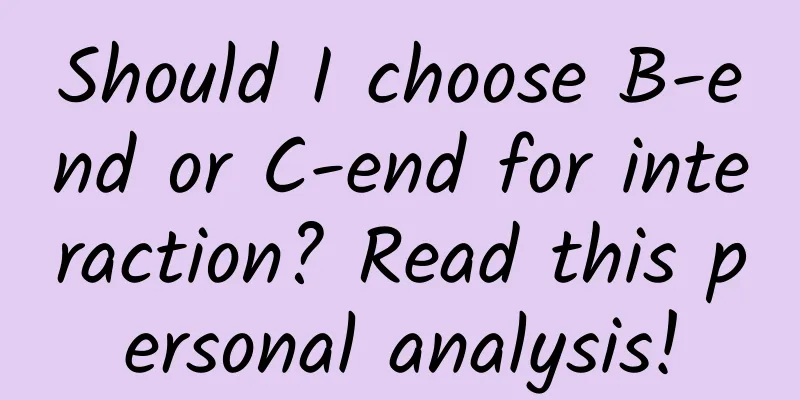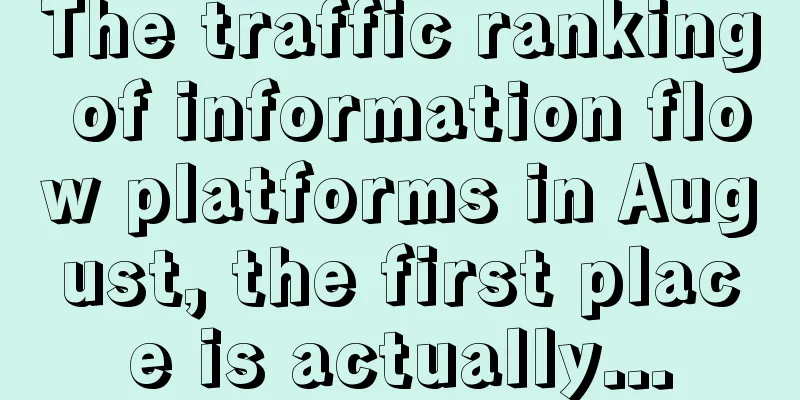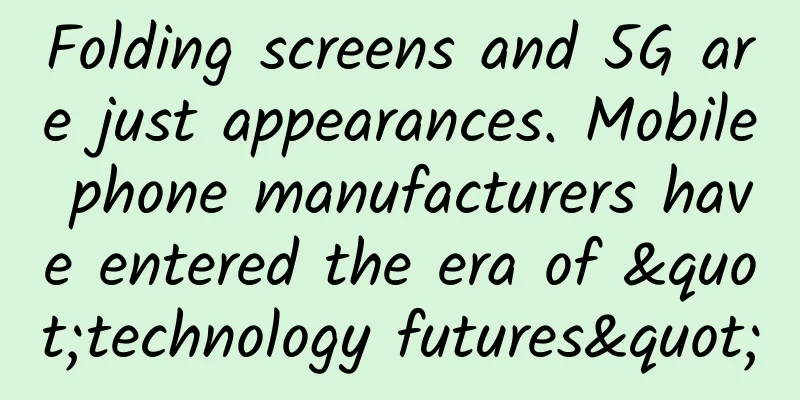Should I choose B-end or C-end for interaction? Read this personal analysis!

|
A few days ago, I was invited to answer this question on Zhihu. I suddenly remembered that when I was interviewing designers, I would ask them: "What are the differences between B-end and C-end design?" From this, we can see that the comparison between B-end and C-end has always been a hot topic, which has never stopped and will not stop in the future. Today, I will talk about my views on "Whether to choose B-end or C-end for interaction".
What is Interaction Design?Baidu Encyclopedia definition: Interaction Design (IXD) is a design field that defines and designs the behavior of artificial systems. It defines the content and structure of communication between two or more interacting individuals so that they can cooperate with each other and achieve a certain goal. Interaction design strives to create and establish meaningful relationships between people and products and services, with the focus on "embedding information technology in a material world full of social complexity." The goal of interactive system design can be analyzed from the two levels of "usability" and "user experience", focusing on people-oriented user needs. The International Interaction Design Association (IXDA) defines: Interaction designers aim to create useful and practical products and services. With user-centeredness as the basic principle of design, the actual operation of interaction design must be based on an understanding of actual users: including their goals, tasks, experiences, needs, etc. Starting from a user-centered perspective and striving to balance the relationship between user needs, business development goals and the level of technological development, interaction designers provide solutions to complex design challenges while defining and developing new interactive products and services. As can be seen from the above, the key items of interaction design are: creating and establishing meaningful relationships between people and products and services, creating useful and practical products and services, based on user goals, tasks, experience, and needs, and balancing the relationship between user needs, business development goals, and technological development levels. For both B-end and C-end, the core of interaction design is to design user interfaces based on PC and mobile terminals to solve the problem of human-computer interaction. Therefore, it can be said that interaction design is the designer's understanding of product strategy, target user purposes, tasks, experiences, needs, and understanding of equipment and technology-related information to create useful and practical products, and if possible, define and develop new interaction modes. Based on the above, the author recalls the daily interactive design work. After getting the requirements, it is mainly divided into the following:
Interaction design is the key node that connects product strategy, user experience, and technical feasibility. Its core task is to explore user experience that meets user needs, business development goals, and technological development levels. Similarities and differences in B-end and C-end product designBefore analyzing the similarities and differences between B-end and C-end product design, we need to first understand what is B-end and what is C-end. B-end products are products that provide services to enterprises and solve their pain points, such as financial systems and project management systems. The decision makers of B-end products are bosses, and the users are employees. C-end products are products that solve users' needs and pain points in life, such as Ele.me (takeout), Mafengwo (travel), and Taobao (online shopping). The decision makers and users of C-end products are the users themselves. 1. Commonalities:For B-end and C-end products, the overall design and R&D links are consistent. In terms of the five-element model of user experience, they all need to go through the strategy layer, scope layer, structure layer, framework layer, and presentation layer (from abstract to concrete, from bottom to top). The work scope of interaction designers is in the scope layer, structure layer, and framework layer, and the core work scope is in the structure layer and framework layer. 2. Differences:Since the B-end and the C-end have different businesses and target user groups, there will be differences in product design thinking. The B-side focuses on the thinking of decision makers, while the C-side focuses on pure user thinking.For B-end products, their paying users are the decision makers of the enterprise. Therefore, the design of B-end products should not only consider how to satisfy users (i.e., employees of the enterprise), but also consider the payment thinking of decision makers. C-end products are different. The users and decision makers of C-end products are the same person, both of whom are ordinary people. Therefore, the design of C-end products mainly considers the user's feelings. C-end products are highly homogenized, and the replacement cost of users is very low. C-end products need to use various methods to attract users to retain them. The B-side focuses on efficiency, while the C-side focuses on stickinessIn the original intention of product design, the B-end hopes that users can complete tasks quickly by using the product, rather than spending too much time on the product. But for C-end products, the C-end hopes that users can open their products frequently and spend more time on the products, so the C-end will have user activity indicators, while the B-end generally does not. The B-side focuses on stability, while the C-side focuses on diversityIn terms of user experience, the B-side does not often come up with surprising moves, but rather pursues stability. Usually, software with industry characteristics will form certain industry characteristics. Of course, this also brings certain troubles to the B-side interaction designers. There is not much room for interaction, and the value of interaction designers cannot be experienced. The C-side is actually leading the design industry in terms of user experience. APPs with a large number of users, such as AutoNavi, Taobao, and Ele.me, continue to maximize user experience, explore and break through the boundaries of user experience, bring users diverse experience feelings, and constantly refresh users' mental models. The B-end focuses on simplicity and tranquility, while the C-end focuses on individuality.In terms of user interface visuals, the B-side is mainly plain and quiet because the B-side serves corporate employees, who need to complete tasks quickly through software. The plain and quiet interface does not have too many useless elements to interfere, and the use of any color and layout is to help users complete tasks quickly. In the B-side interface design, Gestalt principles, typography principles, and W3C principles are more valued by designers. For C-side products, the users they face are personalized individuals. If you want to attract users with different personalities and hobbies, you need to spend effort on interface design. Choose B-end or C-end for interactionFrom the essence of interaction design and the differences between B-end and C-end, we can know that as an interaction designer, no matter which field you serve, your job responsibilities are the same, that is, "exploring user experiences that meet user needs, business development goals, and technological development levels. At the same time, define and develop new interactive products and services." However, due to the differences in business attributes and target users between the B-end and the C-end, the work of interaction designers in these two areas will also be different. Interaction designers serving the B-end are more like dancing with shackles. A certain form of interaction may be reasonable, but it will be abandoned if it does not conform to the characteristics of the industry or user habits. There is a sentence that friends who have done B-end interaction should often hear from product managers: "I know this interaction is good, but the original interaction has become a habit for users. We should not change it at will. There are risks." Interaction designers on the C-end are dancing barefoot. It is obvious who is relatively free. There is a lot of room for interaction designers on the C-end to redefine a certain way of interaction. Therefore, many interaction designers will be more inclined to serve C-end products. However, I believe that if you want to be an excellent interaction designer, you will eventually play your value under constraints, and this value will stand the test of time. Excellent B-end and C-end interaction designers are indispensable talents in the industry. If you don’t have a special preference, I think choosing B is the same as choosing C. If you think deeply in a field, you will bloom everywhere. I serve the B-side, and I want to say to the B-side interaction designers that most of us see the B-side on the iceberg, but not the B-side under the iceberg. The B-side under the iceberg is an undeveloped virgin land with infinite value. B-side interaction designers, are you ready to explore and break through? The future B-side experience is defined by you. |
Recommend
The hot-blooded Jianghu chain game idle brick-moving project that sells for 1580 outside [detailed tutorial + idle script]
The hot-blooded Jianghu chain game idle brick-mov...
The fastback shape is the highlight. The new Jingxuan appearance concept map is exposed
The new generation of Mitsubishi ASX has been exp...
Hexingshe Live Broadcast Account Training Camp - Brand new gameplay, Douyin live broadcast account algorithm logic, precise design of account creation hot products
Hexingshe Live Broadcast Account Training Camp - ...
JD X Robotics Challenge Concludes, BUPT Team's Intelligent Robot Wins the Championship
On March 25, as the Water Drop Team of Beijing Un...
One day, when AI learns to smell...
**The sense of smell is one of the earliest sense...
Demonized growth, fission and community!
If you are doing marketing or in the Internet ind...
[Smart Farmers] The Wandering Earth from an Agricultural Perspective: Having Survived Several Extinction Events, This “Living Fossil Fish” May Become Hope for Doomsday
Editor’s Note: The recent hit of "The Wander...
Is the new iPod touch, which has similar configuration to iPhone 6, worth buying?
Early this morning, Apple released the new genera...
How to make a good chess and card game? Just being fun is not enough
The development of the Internet has also led to t...
Is it possible for "time travel" to become a reality? Don't worry, the premise is...
What is time? It seems to be the greatest mystery...
The magic weapon that strengthens plastics may be an "invisible assassin" of health!
Audit expert: Zhou Hongzhi Senior Experimentalist...
Using Domain Events in Microservices
If we think back to the working principle of compu...
B2B marketing tips: online marketing methods!
A world-class epidemic has dealt an unprecedented...
The most prominent part of a smartphone is actually on the side
We have discussed many articles about physical bu...
Cross-border e-commerce: Amazon newbies can open stores around the world with zero basic knowledge
Course Catalog: ├──01. Lesson 1: Understanding Am...









